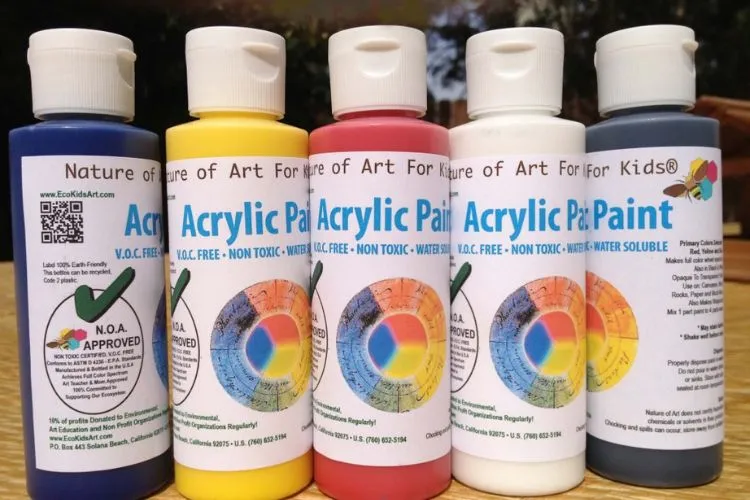Acrylic paints have long been a favorite among artists for their versatility, vibrant colors, and ease of use. These water-based paints have revolutionized the painting process, allowing for quick drying times and the ability to create stunning masterpieces.
However, as environmental consciousness continues to grow, an important question arises: Is acrylic paint eco friendly?

Is acrylic paint eco friendly?
No, acrylic paints are generally not considered eco-friendly. While non-toxic when dry, they contain synthetic polymers and other chemicals that are not biodegradable and can harm the environment if improperly disposed of.
The manufacturing process also consumes energy and may produce pollutants. However, some brands offer more eco-conscious options using natural or plant-based ingredients. Proper usage, storage, and responsible disposal practices can help minimize the environmental impact of acrylic paints to some extent.
You may also like to find out: Is Acrylic Paint Cruelty Free?
Understanding Acrylic Paints
Composition
Acrylic paints are composed of pigments suspended in an acrylic polymer emulsion, along with various additives that enhance their properties. The pigments provide the color, while the acrylic binder acts as the adhesive that binds the pigments to the painting surface.
Additives such as thickeners, preservatives, and driers are often included to modify the paint’s consistency, prevent bacterial growth, and control drying times.
While some acrylic paints may contain natural pigments or binders derived from plant sources, the majority of commercial paints rely on synthetic components. This synthetic nature raises questions about their biodegradability and potential environmental impact.
Manufacturing Process
The manufacturing process of acrylic paints involves several steps, including the synthesis of the acrylic polymer emulsion, the dispersion of pigments, and the addition of other additives.
While the specifics may vary among manufacturers, the production methods generally require energy consumption and can generate waste byproducts.
Environmental concerns may arise from the use of non-renewable resources, the release of greenhouse gases during manufacturing, and the potential for water and air pollution if proper waste management practices are not implemented.
Responsible manufacturers should strive to minimize their environmental footprint by adopting sustainable practices and adhering to environmental regulations.
Environmental Impact of Acrylic Paints

Biodegradability
One of the key considerations when evaluating the eco-friendliness of acrylic paints is their biodegradability. Biodegradability refers to the ability of a material to break down into simpler components through the action of living organisms, such as bacteria and fungi.
Generally, acrylic paints are not considered biodegradable due to the synthetic nature of the acrylic polymer binder. This polymer is designed to be durable and resistant to degradation, ensuring the longevity of the painted surface. However, the degree of biodegradability can vary depending on the specific formulation and additives used in the paint.
Some manufacturers have started exploring the use of biodegradable acrylic polymers derived from renewable sources, such as plant-based materials. While these efforts are commendable, the widespread availability and affordability of such products may still be limited.
Toxicity
Another aspect to consider is the potential toxicity of acrylic paint components. While acrylic paints are generally regarded as non-toxic once fully cured, certain ingredients used in their formulation can raise concerns.
Pigments, for instance, may contain heavy metals like cadmium or lead, which can be harmful to human health and the environment if not handled or disposed of properly. Additionally, some additives, such as biocides and preservatives, may pose risks to aquatic life or contribute to environmental pollution.
It’s essential to carefully read the product labels and safety data sheets provided by manufacturers to understand the specific components and potential hazards associated with each paint product. Proper ventilation, personal protective equipment, and responsible disposal practices should be followed to mitigate potential risks.
Water Pollution
The improper disposal of acrylic paint waste can contribute to water pollution, posing risks to aquatic ecosystems and potentially contaminating water sources. When acrylic paints are washed down drains or released into waterways, the pigments, binders, and additives can accumulate and disrupt the delicate balance of these environments.
To address this concern, it’s crucial to follow proper disposal methods for leftover paints, cleaning water, and other related materials. Many communities offer hazardous waste disposal programs or recycling facilities specifically designed to handle paint waste responsibly.
Eco-Friendly Alternatives
While acrylic paints present challenges in terms of their environmental impact, there are eco-friendly alternatives available for artists seeking more sustainable options.
Natural Paints
One alternative is to explore the use of natural, plant-based paints. These paints often rely on ingredients derived from renewable sources, such as milk proteins, plant oils, and earth pigments. Examples include milk paints, casein paints, and earth pigment paints.
While natural paints may have limitations in terms of color range or longevity compared to acrylics, they offer a more environmentally conscious choice. Additionally, artists can experiment with creating their own paints using natural materials, further reducing their environmental footprint.
Recycled and Upcycled Materials
Another approach is to incorporate recycled and upcycled materials into art projects. Instead of relying solely on traditional art supplies, artists can explore the creative potential of repurposing discarded items or found objects.
This practice not only reduces waste but also encourages artists to think outside the box and embrace a more sustainable mindset. From creating collages with recycled paper and fabrics to sculpting with discarded plastics, the possibilities for upcycled art are endless.
Tips for Sustainable Painting Practices
While eco-friendly alternatives are available, many artists may still choose to work with acrylic paints due to their versatility and familiarity. In such cases, adopting sustainable practices can help minimize the environmental impact of acrylic painting.

Proper Usage and Storage
One of the most effective ways to reduce waste and extend the lifespan of acrylic paints is through proper usage and storage.
By carefully managing paint quantities, avoiding over-purchasing, and properly sealing containers after use, artists can minimize the need for frequent replacements and reduce the risk of paint drying out prematurely.
Additionally, storing paints in airtight containers and at appropriate temperatures can help maintain their quality and prevent premature degradation, further reducing waste.
Responsible Disposal
When it comes time to dispose of leftover acrylic paints or related materials, it’s crucial to follow responsible disposal methods. Many communities offer hazardous waste disposal programs or recycling facilities specifically designed to handle paint waste responsibly.
Artists should avoid pouring paint or cleaning water down drains or into waterways, as this can lead to environmental pollution. Instead, they should allow excess paint to dry completely before disposing of it as solid waste or through designated hazardous waste channels.
Supporting Eco-Friendly Brands
As consumers, artists have the power to influence the market by supporting eco-friendly brands that prioritize sustainability in their manufacturing processes and product offerings. These brands often use recycled materials, renewable resources, or biodegradable components in their paints, reducing the environmental impact.
When purchasing acrylic paints, artists can look for certifications or labels that indicate the product’s environmental credentials, such as the Green Seal or the Cradle to Cradle certification.
By making conscious choices and supporting responsible manufacturers, artists can drive the industry towards more sustainable practices.
Conclusion:
While acrylic paints offer numerous advantages for artists, their environmental impact cannot be ignored. From their synthetic composition and potential toxicity to concerns over water pollution and non-biodegradability, these paints present challenges in terms of eco-friendliness.
However, by understanding these issues and exploring eco-friendly alternatives like natural paints and upcycled materials, artists can make more sustainable choices.
Additionally, adopting responsible practices such as proper usage, storage, and disposal methods can significantly reduce the environmental footprint of acrylic painting.
Ultimately, the pursuit of artistic expression and environmental stewardship need not be mutually exclusive. By embracing sustainable practices and supporting eco-friendly initiatives, artists can continue creating beautiful works while minimizing their impact on the planet.
Together, we can foster a future where art and environmental consciousness coexist harmoniously, inspiring others to embrace a more sustainable way of life.

Meet Isabella Anderson, your acrylic painting mentor with over a decade of brush-wielding mastery. Dive into the colorful world of acrylics with her expert guidance, featured exclusively on ‘Acrylic Authority.’ Unleash your inner artist and explore the limitless possibilities of this versatile medium alongside a true acrylic aficionado.
